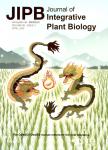Heterozygosity of Knob-Associated Tandem Repeats and Knob Instability in Mitotic Chromosomes of Zea (Zea mays L. and Z. diploperennis Iltis Doebley)
Heterozygosity of Knob-Associated Tandem Repeats and Knob Instability in Mitotic Chromosomes of Zea (Zea mays L. and Z. diploperennis Iltis Doebley)作者机构:China-UK HUST-RRes (Rothamsted Reseach UK) Genetic Engineering and Genomics Joint Laboratory Huazhong University of Science and Technology (HUST) Wuhan 430074 China Key Laboratory of the Ministry of Education for Plant Developmental Biology Wuhan University Wuhan 430072 China
出 版 物:《Journal of Integrative Plant Biology》 (植物学报(英文版))
年 卷 期:2005年第47卷第11期
页 面:1345-1351页
核心收录:
学科分类:0710[理学-生物学] 07[理学] 09[农学] 0901[农学-作物学] 0703[理学-化学] 0902[农学-园艺学]
基 金:国家自然科学基金 国家高技术研究发展计划(863计划) 国家重点基础研究发展计划(973计划)
主 题:fluorescence in situ hybridization knob repetitive DNA sequence Zea diploperennis Z. mays.
摘 要:Knobs are blocks of heterochromatin present on chromosomes of maize (Zea mays L.) and its relatives that have effects on the frequency of genetic recombination, as well as on chromosome behavior. Knob heterozygosity and instability in six maize inbred lines and one Z. diploperennis Iltis Doebley line were investigated using the fluorescence in situ hybridization (FISH) technique with knob-associated tandem repeats (180 bp and 350 bp (TR- 1)) as probes. Signals of seven heterozygous knobs containing 180- bp repeats and of one heterozygous knob containing TR- 1 were captured in chromosomes of all materials tested according to the results of FISH, which demonstrates that the 180-bp repeat is the main contributor to knob heterozygosity compared with the TR- 1 element. In addition, one target cell with two TR- 1 signals on one homolog of chromosome 2L, which was different from the normal cells in the maize inbred line GB57, was observed, suggesting knob duplication and an instability phenomenon in the maize genome.



